|
Size: 9705
Comment:
|
Size: 10365
Comment:
|
| Deletions are marked like this. | Additions are marked like this. |
| Line 1: | Line 1: |
| ## page was renamed from brainsuiteBDP ## page was renamed from brainsuite |
'''[TUTORIAL UNDER CONSTRUCTION: NOT READY FOR PUBLIC USE]''' ---- |
| Line 6: | Line 8: |
| '''[TUTORIAL UNDER WRITING: NOT READY FOR PUBLIC USE]''' | In this tutorial, we describe the estimation of realistic conductivity tensors of living brain tissues using the [[http://brainsuite.org/|BrainSuite software]]. These results are used in FEM forward modeling, as described in the tutorials: [[https://neuroimage.usc.edu/brainstorm/Tutorials/Duneuro#DUNEuro_options:_Advanced|FEM with DUNEuro]] and [[https://neuroimage.usc.edu/brainstorm/Tutorials/FemMedianNerve#FEM_tensors|FEM median nerve example]]. |
| Line 8: | Line 10: |
| In this tutorial, we describe the process of the estimation of the realistic conductivity tensors for the brain tissues using the [[http://brainsuite.org/|BrainSuite software]]. The main purpose is to generate the conductivity tensor for the FEM computation as introduced on [[https://neuroimage.usc.edu/brainstorm/Tutorials/Duneuro|this page]]. | The realistic tensors are estimated from the Diffusion-Weighted Images (DWI): Brainstorm calls the BrainSuite software to compute the diffusion tensors on each brain MRI voxel (DTI), then Effective Medium Approach (EMA) is applied to estimate the conductivity tensors for each element of a tetrahedral FEM mesh. This is particularly interesting for the modeling the anisotropy of the white matter. |
| Line 10: | Line 12: |
| The realistic tensors are estimated from the Diffusion-Weighted Images (DWI). For this purpose, Brainstorm calls internally the BrainSuite software to compute the diffusion tensors on each brain voxel. Afterward, the Effective Medium Approach (EMA) is applied to convert the diffusion tensors to the conductivity tensors. The following section shows the users how to do it from the Brainstorm graphical interface. Further documentation about previous usage of Brainsuite within Brainstorm can be found in this [[https://neuroimage.usc.edu/brainstorm/Tutorials/SegBrainSuite |page]]. |
BrainSuite is also used for other purposes in Brainstorm, particularly the T1 MRI segmentation, as documented in this tutorial: [[Tutorials/SegBrainSuite|MRI segmentation: BrainSuite]]. |
| Line 18: | Line 16: |
| == Requirement == * You have already followed all the introduction tutorials * You have a working copy of Brainstorm installed on your computer * Only the Nifti file are supported |
== Download and installation == ==== Requirements ==== * You have already followed all the introduction tutorials. * You have a working copy of Brainstorm installed on your computer. * For the DWI data, only the NIfTI files (.nii) are supported. |
| Line 23: | Line 22: |
| == Brainsuite Installation == 1. Download the latest version of BrainSuite from http://www.brainsuite.org/download. |
==== Install Brainsuite ==== 1. Download the latest version of BrainSuite from http://forums.brainsuite.org/download/. |
| Line 28: | Line 27: |
| 1. Note that you will be using BrainSuite Diffusion Pipeline(BDP), so you need to install a compatible [[http://www.mathworks.com/products/compiler/mcr|MATLAB Compiler Runtime]](last version). | 1. You will be using BrainSuite Diffusion Pipeline (BDP), so you need to install a compatible [[https://www.mathworks.com/products/compiler/matlab-runtime.html|MATLAB Runtime]] (2019b for BrainSuite 21a). |
| Line 30: | Line 29: |
| 1. Start BrainSuite to check if the installation (It's not required to open BrainSuite to run this tutorial). | 1. In Brainstorm, menu File > Edit preferences > Enter the BrainSuite installation folder:<<BR>><<BR>> {{attachment:brainsuiteInstall.gif}} |
| Line 32: | Line 31: |
| 1. The BrainSuite installation folder should be informed in the Brainstorm preferences | ==== Download the dataset ==== * Download the files: [[http://brainsuite.org/WebTutorialData/BrainSuiteTutorialSVReg_Sept16.zip|MRI T1w]] and [[http://brainsuite.org/WebTutorialData/DWI_Feb15.zip|MRI DWI]] (from the [[http://brainsuite.org/tutorials/dtiexercise/|BrainSuite diffusion tutorial]]). |
| Line 34: | Line 34: |
| {{attachment:brainsuiteInstalation.JPG||height="250",width="650"}} | * Unzip it outside of any of the Brainstorm folders (program folder or database folder). * Start Brainstorm (Matlab scripts or stand-alone version) * Select the menu File > Create new protocol. Name it "'''TutorialTensors'''" and select: * No, use individual anatomy * No, use one channel file per condition |
| Line 36: | Line 40: |
| ---- == Dataset == In this tutorial, we use the Brainsuite dataset example available on the BrainSuite [[http://brainsuite.org/tutorials/|tutorial webpage]]. User can also download directly these data from these links: [[http://brainsuite.org/WebTutorialData/BrainSuiteTutorialSVReg_Sept16.zip|MRI T1w]] [[http://brainsuite.org/WebTutorialData/DWI_Feb15.zip|MRI DWI]] |
== Import the anatomy == === T1 MRI === * Switch to the "anatomical data" view, the left button in the toolbar above the database explorer. * Right-click on the TutorialFem folder > New subject > '''Subject01''' * Keep the default options you set for the protocol. |
| Line 40: | Line 46: |
| The first file contains the T1 MRI data, with the name '2523412.nii.gz'. as in this figure, | * Right-click on the subject node > '''Import MRI''': * Set the file format: '''All MRI files (subject space)''' |
| Line 42: | Line 49: |
| {{attachment:vierMriFolder.JPG||height="130",width="580"}} | * Select the T1 file: BrainSuiteTutorialSVReg/'''2523412.nii.gz''' |
| Line 44: | Line 51: |
| The second file is the DWI and should contain at least three files | * Click on the link "'''Click here to compute MNI normalization'''": option "'''maff8'''". This estimates an affine transformation to the [[https://neuroimage.usc.edu/brainstorm/CoordinateSystems#MNI_coordinates|MNI space]] and sets default positions for the anatomical fiducials. The NAS/LPA/RPA fiducials are needed for defining the Brainstorm [[CoordinateSystems|subject coordinate system]], in which the surfaces and FEM meshes are stored. <<BR>><<BR>> {{attachment:importT1.gif}} |
| Line 46: | Line 53: |
| {{attachment:vierDWIFolder.JPG||height="150",width="580"}} | === Diffusion imaging === This computes the This requires BrainSuite to be installed on your computer, with the bdp program available in the system path. |
| Line 48: | Line 56: |
| Where the *.bval is a text file that contains the value of the gradient, and the *.bvec is also a text file that contains the orientation of the gradient. The nii.gz file is the NifTi file of the DWI where the images are stored. | * Right-click on Subject01''' '''> '''Convert DWI to DTI''' |
| Line 50: | Line 58: |
| == Realistic condctivity tensors == === Load the T1 MRI data to brainstorm === First, you need to create a new subject in your protocol, let call it the 'BrainSuiteSubject'. Then import the T1 MRI of the subject and set the fiducials points as explained in the [[https://neuroimage.usc.edu/brainstorm/Tutorials/ImportAnatomy|previous tutorial]]. |
* Select the DWI file: DWI/'''2523412.dwi.nii.gz''' |
| Line 54: | Line 60: |
| The T1 MRI is required since all the BDP uses the T1 space for its computation. Furthermore, this is required since it will be used to align the tensors to the FEM mesh later. | * The associated text files '''*.bvec''' (orientation of the gradient) and '''*.bval''' (value of the gradient) must be in the same folder, with the same file name. Theses files are created from for the DWI acquisition. If you don't have them, ask the person who programmed your DWI sequence and get the files that are specific to your use case. |
| Line 56: | Line 62: |
| {{attachment:mri.JPG||height="100",width="250"}} | * The process can take up to 30min. At the end, a new file '''DTI-EIG''' appears in the database (DTI=diffusion tensors images, EIG=eigenvalue). This file contains 12 volumes, ie. 12 values for each voxel. From 1 to 9: components of the three eigenvectors; from 10 to 12: the values of their norm to the eigenvalue. <<BR>><<BR>> {{attachment:importDTI.gif}} |
| Line 58: | Line 64: |
| === Diffusion tensor generation (DTI) from DWI === In this step, Brainstorm calls the Brainsuite internally, and the diffusion tensors are computed. |
== FEM mesh == The FEM approach requires a segmentation of the head volume in different tissues, represented as hexahedral or tetrahedral 3D meshes. The methods available within Brainstorm are listed in the tutorial [[https://neuroimage.usc.edu/brainstorm/Tutorials/FemMesh|FEM mesh generation]]. |
| Line 61: | Line 67: |
| Right-click on the subject and then select the item "Convert DWI to DTI". | Here we illustrate only the use of '''Brain2mesh''': this is not the most accurate solution for MRI segmentation but it is probably the fastest solution to obtain a tetrahedral mesh of the head with 5 tissues (gray matter, white matter, CSF, skull, skin). For more accurate results, we recommend using '''SimNIBS with T1+T2''', as illustrated in the tutorial [[https://neuroimage.usc.edu/brainstorm/Tutorials/FemMedianNerve#FEM_mesh_with_SimNIBS|FEM median nerve example]]. |
| Line 63: | Line 69: |
| {{attachment:dwi2dti.jpg||height="300",width="550"}} | * Right-click on the T1 MRI > MRI segmentation > '''Generate FEM mesh''' > '''Brain2mesh'''.<<BR>><<BR>> {{attachment:femMesh1.gif}} * After less than 15 minutes, you will obtain a new FEM mesh in the database.<<BR>><<BR>> {{attachment:femMesh2.gif}} |
| Line 65: | Line 72: |
| Then follow the popup windows by selecting the DWI, you may need to extract the zip file before. | == FEM conductivity tensors == Once the FEM mesh and the DTI tensors are available in the Brainstorm database, the next step is to compute the conductivity tensor for each of the FEM mesh element. |
| Line 67: | Line 75: |
| {{attachment:importDWI.JPG||height="280",width="650"}} | * Right-click on the FEM mesh > '''Compute FEM tensors'''. * Brainstorm checks the available tissues in the FEM mesh and assigns a default '''isotropic conductivity''' value of the conductivity for each compartment. Users can change these values to their own if needed. * When selecting "'''Anisotropic'''" for a tissue, the DTI values are used to generate conductivity tensors: this is used mostly for the '''white matter''' (and in some cases for the grey matter). Note that DWI can be used only for the brain tissues and not for the outers compartments (skull and skin). The methods available are: * '''EMA''': Effective Medium Approach: See [[http://www.pnas.org/content/98/20/11697|(Tuch 2001)]]. * '''EMA + VC''': EMA with volume constraints: The final tensors are constrained to fit the volume of the equivalent isotropic tensor volume. * '''Simulated''': Artificial anisotropy (DTI is not required) * For this example, select: WM:Anisotropic and Isotropic for the other tissues, EMA+VA.<<BR>><<BR>> {{attachment:computeTensors.gif}} * The FEM conductivity tensors are saved in the the FEM mesh file, in the field Tensors.<<BR>><<BR>> {{attachment:femContents.gif}} |
| Line 69: | Line 84: |
| If the bval, and bval files are in the same folder, Brainstorm will detect them automatically, otherwise, the user will be asked to browse the files one by one (as it's the case in this tutorial). | == Visualization == * Right-clicking on the FEM head > '''Display FEM tensors'''. The tensors can be displayed as ellipsoids or arrows (vectors in the direction of the main eigenvector) and overlaid on the MRI slices or the FEM mesh. <<BR>><<BR>> {{attachment:displayMenu.gif}} * On the FEM mesh: left=ellipsoids, right=arrows<<BR>><<BR>> {{attachment:femDisp1.gif}} * On the 3D MRI slices: left=ellipsoids, right=arrows: <<BR>><<BR>> {{attachment:femDisp2.gif}} * The orientation of the tensor is color-coded as follows: * '''Red''': right-left * '''Green''': anterior-posterior * '''Blue''': superior-inferior * To configure the diplay: * Right-click on the figure > '''FEM tensors'''. * Use the '''Resect sliders''' in the Surface to move the slices (or right-click+move for 3D MRI) * Use the keyboard shortcuts '''Up''' and '''Down''' to change the size of the graphical elements representing the tensors. |
| Line 71: | Line 97: |
| Brainstorm calls internally the BrainSuite process, and compute the diffusion tensors. At the end of this process, a new node will appear in the Brainstorm database with the name 'DTI-EIT'. This name refers to, DTI: diffusion tensors images, and EIG for eigenvalue, since the eigenvalues and eigenvectors are computed at voxel and stored in Brainstorm database. {{attachment:mriAndDTI-EIG.JPG||height="100",width="230"}} If you check the structure of the file DTI-EIG, by right click -> File and then 'Display file contents', the following figure is displayed. {{attachment:EIG-hardDisc.JPG||height="200",width="450"}} The size of the matrix is 128x256x256x12, where the first 3 values are the same as the size of the T1 MRI and 12 corresponds to the 3 eigenvectors components (9) and eigenvalues (3) === Conductivity tensor generation from DTI === The Effective Medium Approach is applied to convert the diffusion tensors to the conductivity tensors. ==== FEM mesh head model ==== This step requires the FEM mesh of the head model. You can generate the FEM head model from the MRI data as explained on [[https://neuroimage.usc.edu/brainstorm/Tutorials/FemMesh|this page]]. For the following, we used the SimNibs FEM mesh generation. The following figure shows the FEM mesh obtained with the SimNibs method using the T1 MRI. {{attachment:Mri&femMeshView.JPG|Mri&femMeshView.JPG|height="300",width="260"}} {{attachment:femMeshView.JPG||height="300",width="280"}} Note that this mesh is obtained only from the T1, the use of the T2 is highly recommended if it's available, as recommended in the [[https://neuroimage.usc.edu/brainstorm/Tutorials/FemMesh|FEM mesh tutorial]]. ==== Computation of FEM mesh tensors ==== Once the FEM mesh and the DTI tensors are available in the Brainstorm database, the next step for the FEM tensors can be performed by the following: - Right-click on the FEM mesh - Compute FEM tensors {{attachment:menuGenerateFemTensors.png||height="280",width="250"}} Brainstorm checks the available tissues in the FEM head model and displays the following panel {{attachment:FEMConductivitiesIsoPanel.JPG||height="220",width="250"}} This panel lists the tissues available in the FEM head model and assigns a default value of the conductivity for each compartment. Users can change these values to their own if needed. DTI values can be used to generate conductivity tensors for the white matter (and in some cases for the grey matter). Please, note that the DWI can be used only for the brain tissues and not for the outers compartments (skull and skin) In this tutorial (and in most cases) we select the white matter. Select the WM anisotropy and keep all the other tissues as isotropic, then these additional options appear asking for the method to use. {{attachment:FEMConductivitiesAnisoPanel.JPG||height="300",width="250"}} The available methods are: - Effective Medium approach (EMA) - Effective Medium approach with volume constraints (EMA + VC) - Simulated or the artificial anisotropy Only the two first methods require the DTI. More information about these methods can be found on these references [ref1][ref2] and in our main paper [link] In this tutorial, we use the method "EMA + VC", where the final tensors are constrained to fits the volume of the equivalent isotropic tensor volume. ==== Visulation of FEM mesh tensors ==== Once the FEM tensors are successfully computed, they are stored in the FEM head node. By right-clicking on the FEM head, new menu items are added that gives the possibilities to display the FEM tensors either as ellipsoids or as vectors in the direction of the main eigenvector. {{attachment:menuDisplayTensors.jpg||height="300",width="250"}} The tensors can be displayed either on the FEM mesh or overlaid on the MRI. The following figures show an example of the obtained tensors displayed on the white matter. {{attachment:meshViewTensorsLines.JPG||height="300",width="350"}} {{attachment:meshViewTensorsTensorsTops.JPG||height="300",width="350"}} On the left, the tensors as a line on the direction of the main eigenvector. On the right, the tensors displayed as ellipsoids. The orientation of the tensor is color-coded as follows: red for right-left, green for anterior-posterior, and blue for superior-inferior. Note that the quality of the tensors depends on the DWI data and the number of acquisition direction. Users can also display the tensors on specific tissues, for example on the white matter (left figure) or overlay on the MRI (right figure). {{attachment:meshViewTensorsLinesWM2.JPG||height="300",width="350"}} {{attachment:tensorsOnMri.JPG||height="300",width="300"}} ==== Recommendation ==== In the case where the user wants to use generate isotropic tensors, then the DTI is not required. In the case where more than one FEM head model is in the database, the highlighted one in the green color will be used. |
* Note that the quality of the tensors depends on the DWI data and the number of acquisition direction. |
| Line 148: | Line 101: |
| == Artificial/simulated conductivity tensors == In the case where the DWI is not available, or in the case where the users desire to evaluate the effect of the conductivity change on the model, the artificial conductivity can be used. |
== Simulated conductivity tensors == When the DWI is not available, or to evaluate the effect of the conductivity change on the head model, artificial conductivities can be used using the third option '''Simulated'''. Two approaches are integrated within Brainstorm: '''Wang''' or '''Volume''' constraint. The common feature between these methods is the ratio between the transversal and longitudinal conductivity ratio. |
| Line 151: | Line 104: |
| Two approaches are integrated within Brainstorm. Either the | A common example is the skull anisotropy simulation, where the longitudinal conductivity can be higher than the transversal conductivity, the ratio can vary from 2 to 10 '''[ref]'''. |
| Line 153: | Line 106: |
| == References == | * Right-click on the FEM mesh > '''Compute FEM tensors'''. * Keep all the tissue as isotropic except the skull, configure as below: <<BR>><<BR>> {{attachment:simul1.gif}} * Below: eigenvalues parallel (longitudinal) and perpendicular (transverse) to the fiber directions for 1:10 anisotropy (transverse:longitudinal).<<BR>><<BR>> {{attachment:simul2.gif}} == Additional documentation == ==== Related tutorials ==== * [[https://neuroimage.usc.edu/brainstorm/Tutorials/Duneuro|Realistic head model: FEM with DUNEuro]] * [[https://neuroimage.usc.edu/brainstorm/Tutorials/FemMesh|FEM mesh generation]] * [[https://neuroimage.usc.edu/brainstorm/Tutorials/FemTensors|FEM tensors estimation]] ==== Articles ==== * Medani T, Garcia-Prieto J, Tadel F, Schrader S, Joshi A, Engwer C, Wolters CH, Mosher JC, Leahy RM, [[https://www.spiedigitallibrary.org/conference-proceedings-of-spie/11595/1159554/Realistic-head-modeling-of-electromagnetic-brain-activity--an-integrated/10.1117/12.2580935.short?SSO=1|Realistic head modeling of electromagnetic brain activity: An integrated Brainstorm pipeline from MRI data to the FEM solution]] ([[http://arxiv.org/abs/2011.01292|preprint]]), '''SPIE Medical Imaging''', 2021 * Tuch DS, Wedeen VJ, Dale AM, George JS, Belliveau JW, [[https://www.pnas.org/content/98/20/11697|Conductivity tensor mapping of the human brain using diffusion tensor MRI]], '''PNAS''', 2001 |
[TUTORIAL UNDER CONSTRUCTION: NOT READY FOR PUBLIC USE]
FEM tensors estimation with BrainSuite
Authors: Takfarinas Medani, Francois Tadel, Anand Joshi and Richard Leahy
In this tutorial, we describe the estimation of realistic conductivity tensors of living brain tissues using the BrainSuite software. These results are used in FEM forward modeling, as described in the tutorials: FEM with DUNEuro and FEM median nerve example.
The realistic tensors are estimated from the Diffusion-Weighted Images (DWI): Brainstorm calls the BrainSuite software to compute the diffusion tensors on each brain MRI voxel (DTI), then Effective Medium Approach (EMA) is applied to estimate the conductivity tensors for each element of a tetrahedral FEM mesh. This is particularly interesting for the modeling the anisotropy of the white matter.
BrainSuite is also used for other purposes in Brainstorm, particularly the T1 MRI segmentation, as documented in this tutorial: MRI segmentation: BrainSuite.
Contents
Download and installation
Requirements
- You have already followed all the introduction tutorials.
- You have a working copy of Brainstorm installed on your computer.
- For the DWI data, only the NIfTI files (.nii) are supported.
Install Brainsuite
Download the latest version of BrainSuite from http://forums.brainsuite.org/download/.
Install it on your computer by following the instructions in BrainSuite's quick start installation guide.
You will be using BrainSuite Diffusion Pipeline (BDP), so you need to install a compatible MATLAB Runtime (2019b for BrainSuite 21a).
In Brainstorm, menu File > Edit preferences > Enter the BrainSuite installation folder:

Download the dataset
Download the files: MRI T1w and MRI DWI (from the BrainSuite diffusion tutorial).
- Unzip it outside of any of the Brainstorm folders (program folder or database folder).
- Start Brainstorm (Matlab scripts or stand-alone version)
Select the menu File > Create new protocol. Name it "TutorialTensors" and select:
- No, use individual anatomy
- No, use one channel file per condition
Import the anatomy
T1 MRI
- Switch to the "anatomical data" view, the left button in the toolbar above the database explorer.
Right-click on the TutorialFem folder > New subject > Subject01
- Keep the default options you set for the protocol.
Right-click on the subject node > Import MRI:
Set the file format: All MRI files (subject space)
Select the T1 file: BrainSuiteTutorialSVReg/2523412.nii.gz
Click on the link "Click here to compute MNI normalization": option "maff8". This estimates an affine transformation to the MNI space and sets default positions for the anatomical fiducials. The NAS/LPA/RPA fiducials are needed for defining the Brainstorm subject coordinate system, in which the surfaces and FEM meshes are stored.
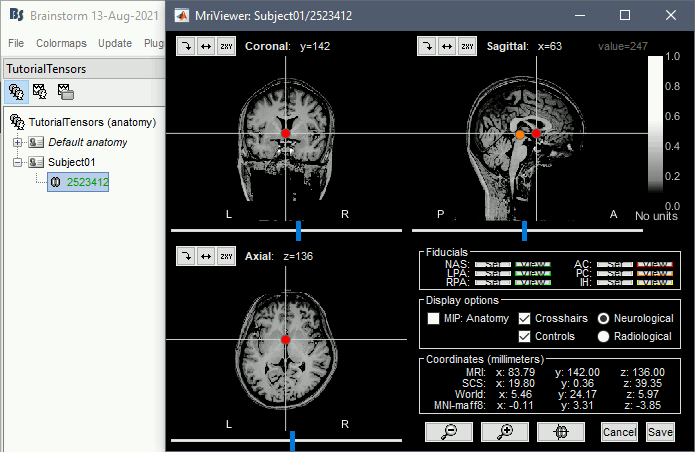
Diffusion imaging
This computes the This requires BrainSuite to be installed on your computer, with the bdp program available in the system path.
Right-click on Subject01 > Convert DWI to DTI
Select the DWI file: DWI/2523412.dwi.nii.gz
The associated text files *.bvec (orientation of the gradient) and *.bval (value of the gradient) must be in the same folder, with the same file name. Theses files are created from for the DWI acquisition. If you don't have them, ask the person who programmed your DWI sequence and get the files that are specific to your use case.
The process can take up to 30min. At the end, a new file DTI-EIG appears in the database (DTI=diffusion tensors images, EIG=eigenvalue). This file contains 12 volumes, ie. 12 values for each voxel. From 1 to 9: components of the three eigenvectors; from 10 to 12: the values of their norm to the eigenvalue.
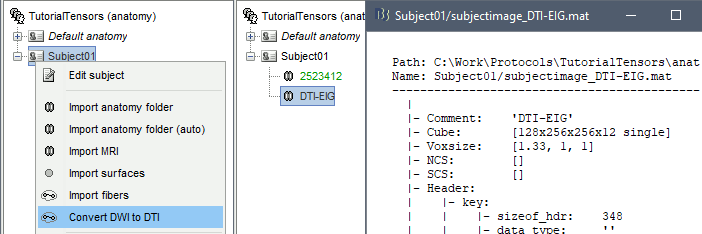
FEM mesh
The FEM approach requires a segmentation of the head volume in different tissues, represented as hexahedral or tetrahedral 3D meshes. The methods available within Brainstorm are listed in the tutorial FEM mesh generation.
Here we illustrate only the use of Brain2mesh: this is not the most accurate solution for MRI segmentation but it is probably the fastest solution to obtain a tetrahedral mesh of the head with 5 tissues (gray matter, white matter, CSF, skull, skin). For more accurate results, we recommend using SimNIBS with T1+T2, as illustrated in the tutorial FEM median nerve example.
Right-click on the T1 MRI > MRI segmentation > Generate FEM mesh > Brain2mesh.
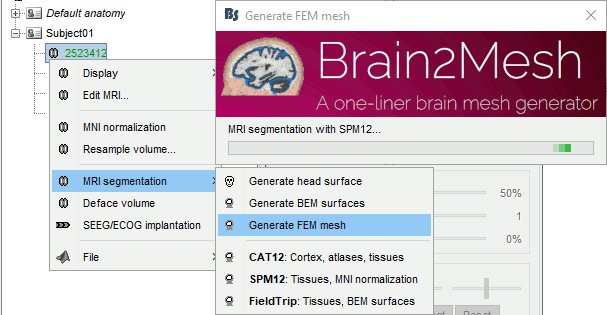
After less than 15 minutes, you will obtain a new FEM mesh in the database.
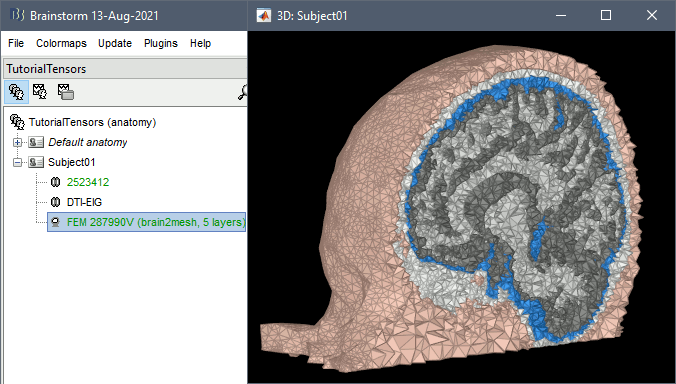
FEM conductivity tensors
Once the FEM mesh and the DTI tensors are available in the Brainstorm database, the next step is to compute the conductivity tensor for each of the FEM mesh element.
Right-click on the FEM mesh > Compute FEM tensors.
Brainstorm checks the available tissues in the FEM mesh and assigns a default isotropic conductivity value of the conductivity for each compartment. Users can change these values to their own if needed.
When selecting "Anisotropic" for a tissue, the DTI values are used to generate conductivity tensors: this is used mostly for the white matter (and in some cases for the grey matter). Note that DWI can be used only for the brain tissues and not for the outers compartments (skull and skin). The methods available are:
EMA: Effective Medium Approach: See (Tuch 2001).
EMA + VC: EMA with volume constraints: The final tensors are constrained to fit the volume of the equivalent isotropic tensor volume.
Simulated: Artificial anisotropy (DTI is not required)
For this example, select: WM:Anisotropic and Isotropic for the other tissues, EMA+VA.
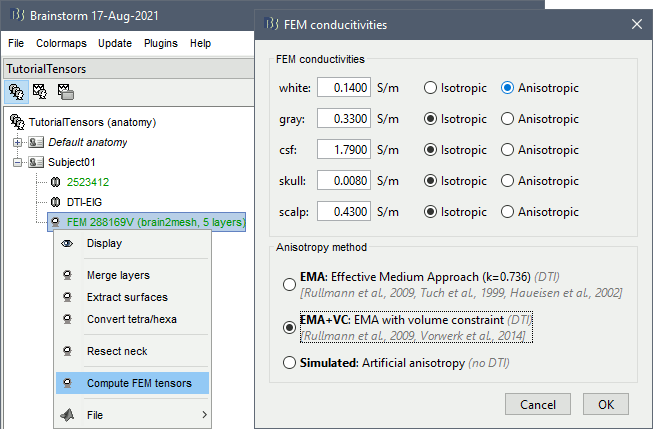
The FEM conductivity tensors are saved in the the FEM mesh file, in the field Tensors.
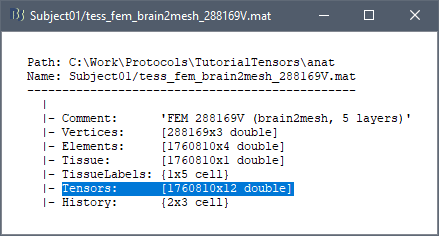
Visualization
Right-clicking on the FEM head > Display FEM tensors. The tensors can be displayed as ellipsoids or arrows (vectors in the direction of the main eigenvector) and overlaid on the MRI slices or the FEM mesh.
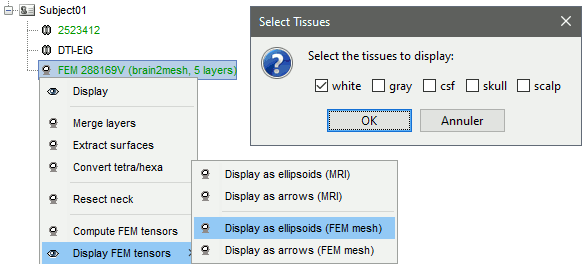
On the FEM mesh: left=ellipsoids, right=arrows
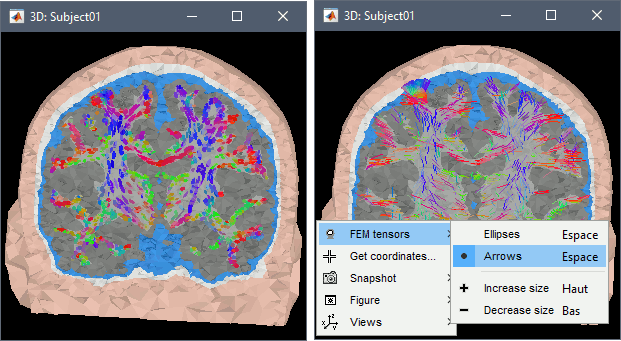
On the 3D MRI slices: left=ellipsoids, right=arrows:
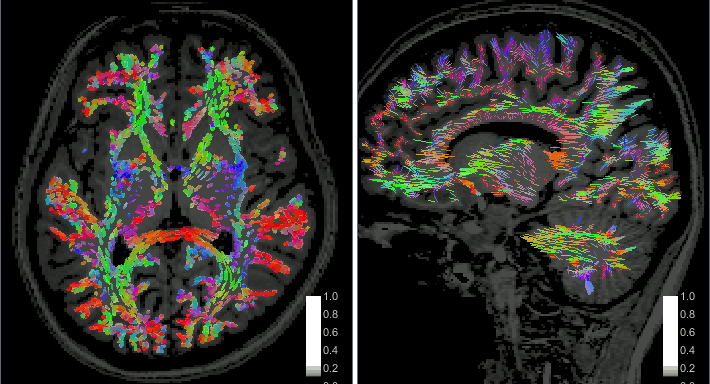
- The orientation of the tensor is color-coded as follows:
Red: right-left
Green: anterior-posterior
Blue: superior-inferior
- To configure the diplay:
Right-click on the figure > FEM tensors.
Use the Resect sliders in the Surface to move the slices (or right-click+move for 3D MRI)
Use the keyboard shortcuts Up and Down to change the size of the graphical elements representing the tensors.
- Note that the quality of the tensors depends on the DWI data and the number of acquisition direction.
Simulated conductivity tensors
When the DWI is not available, or to evaluate the effect of the conductivity change on the head model, artificial conductivities can be used using the third option Simulated. Two approaches are integrated within Brainstorm: Wang or Volume constraint. The common feature between these methods is the ratio between the transversal and longitudinal conductivity ratio.
A common example is the skull anisotropy simulation, where the longitudinal conductivity can be higher than the transversal conductivity, the ratio can vary from 2 to 10 [ref].
Right-click on the FEM mesh > Compute FEM tensors.
Keep all the tissue as isotropic except the skull, configure as below:
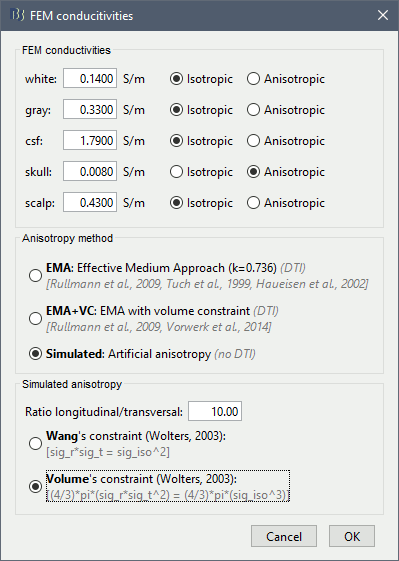
Below: eigenvalues parallel (longitudinal) and perpendicular (transverse) to the fiber directions for 1:10 anisotropy (transverse:longitudinal).
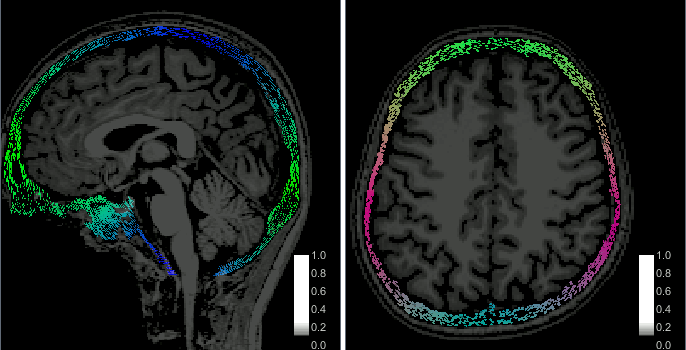
Additional documentation
Related tutorials
Articles
Medani T, Garcia-Prieto J, Tadel F, Schrader S, Joshi A, Engwer C, Wolters CH, Mosher JC, Leahy RM, Realistic head modeling of electromagnetic brain activity: An integrated Brainstorm pipeline from MRI data to the FEM solution (preprint), SPIE Medical Imaging, 2021
Tuch DS, Wedeen VJ, Dale AM, George JS, Belliveau JW, Conductivity tensor mapping of the human brain using diffusion tensor MRI, PNAS, 2001
